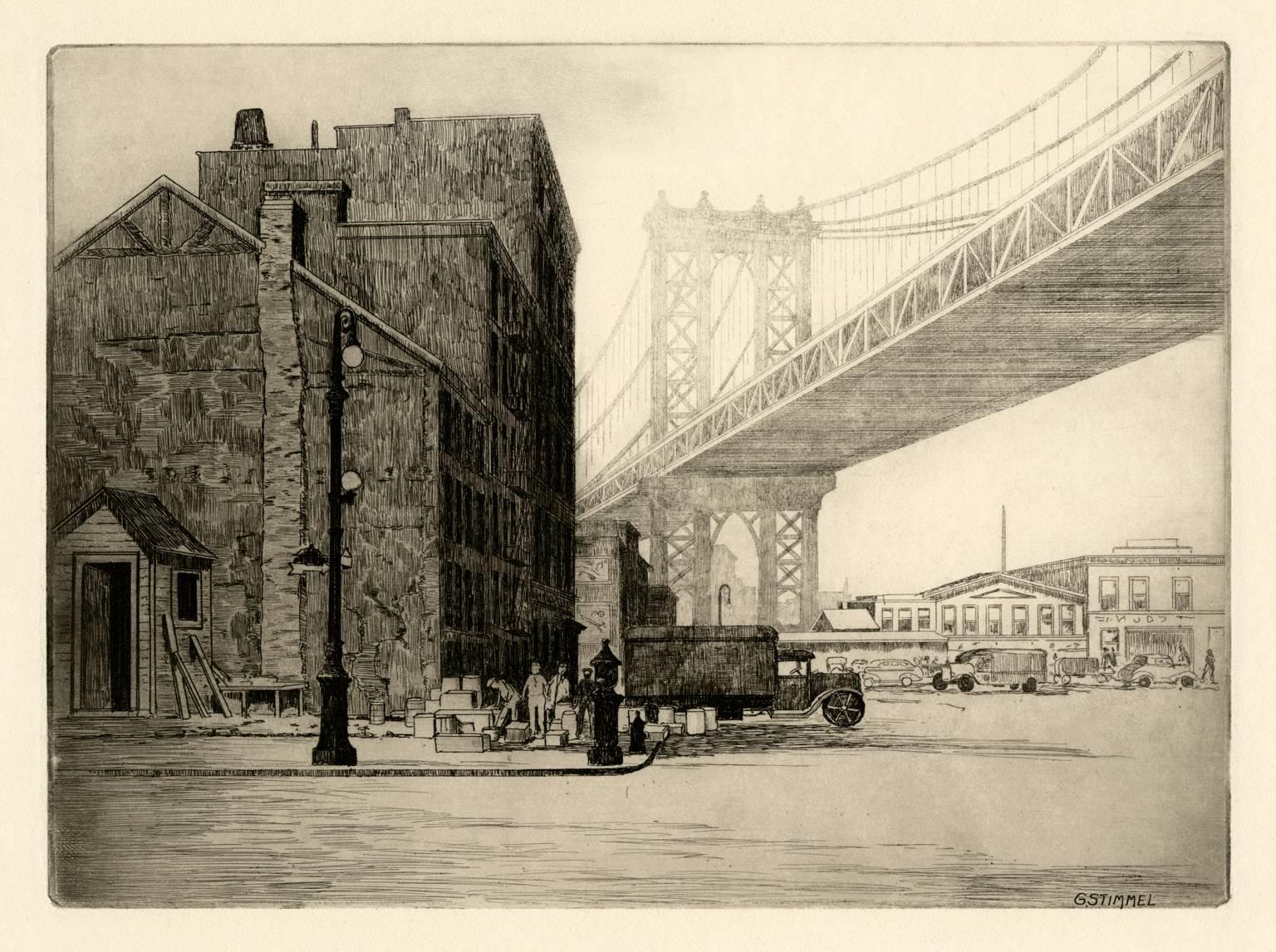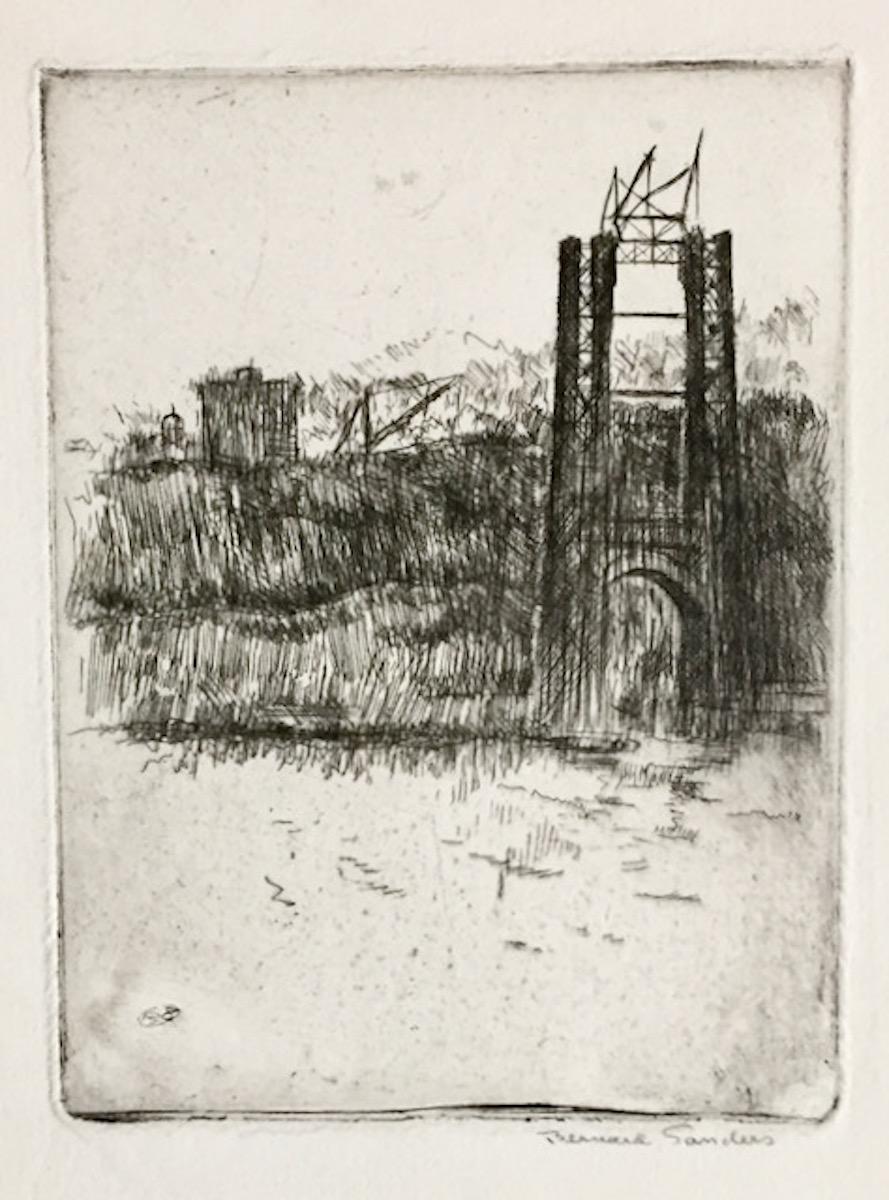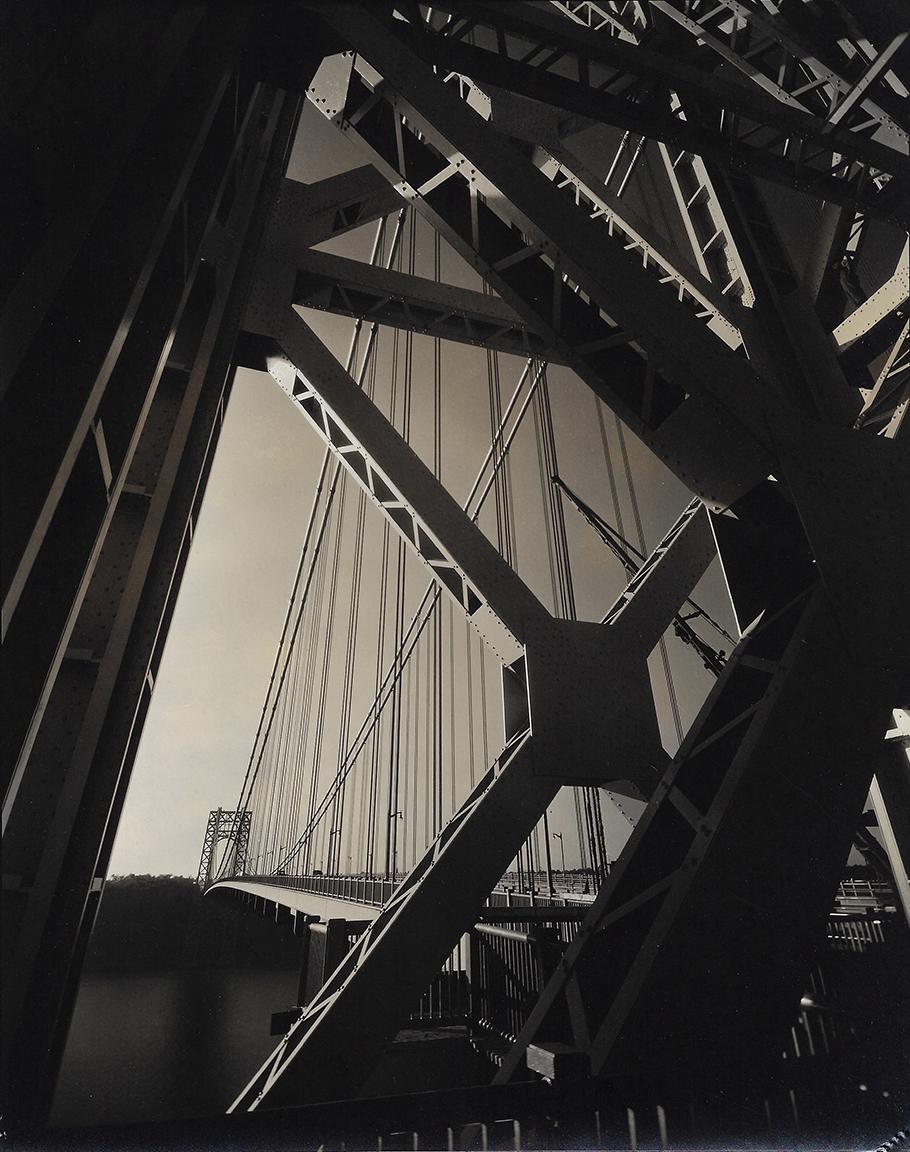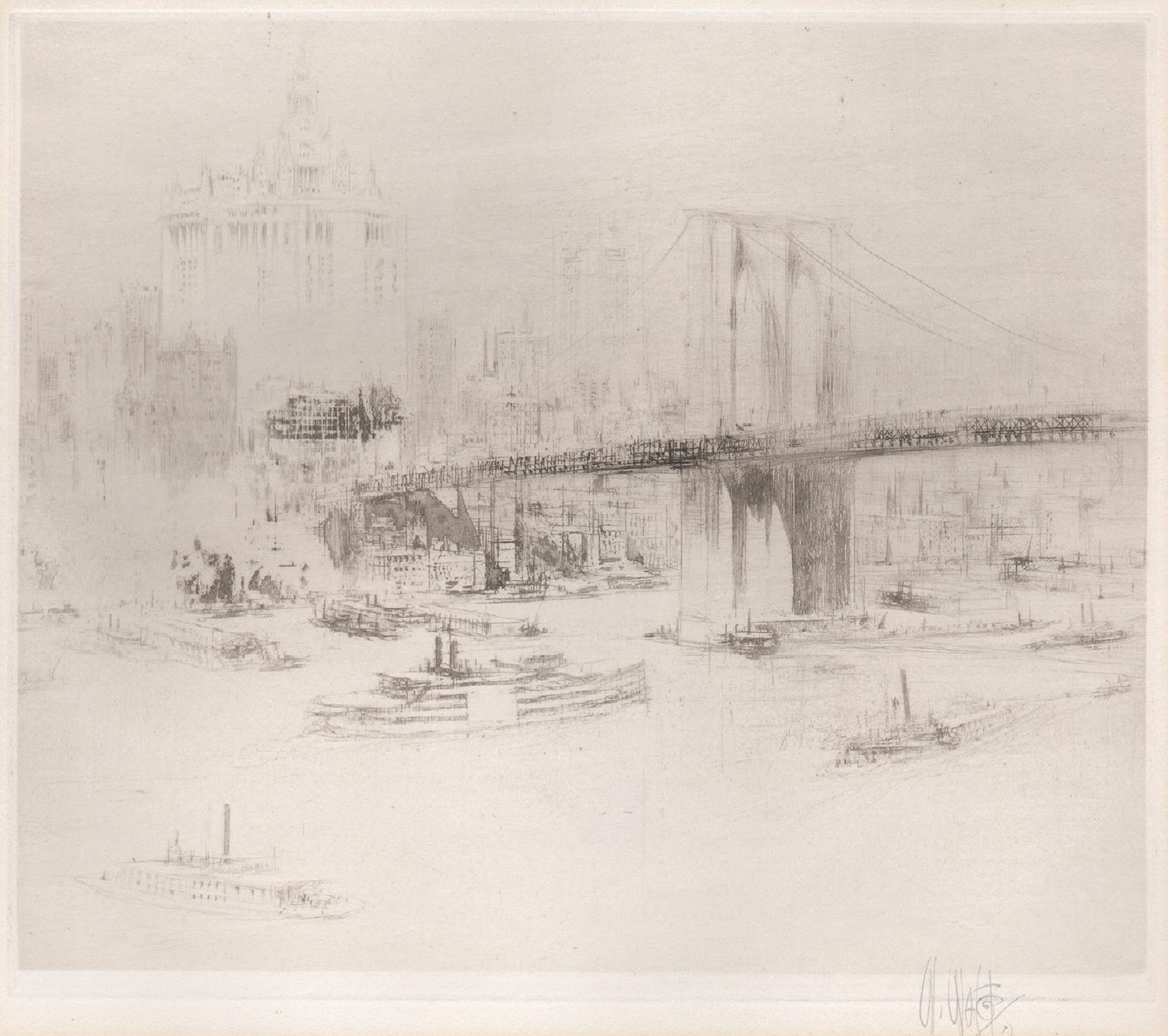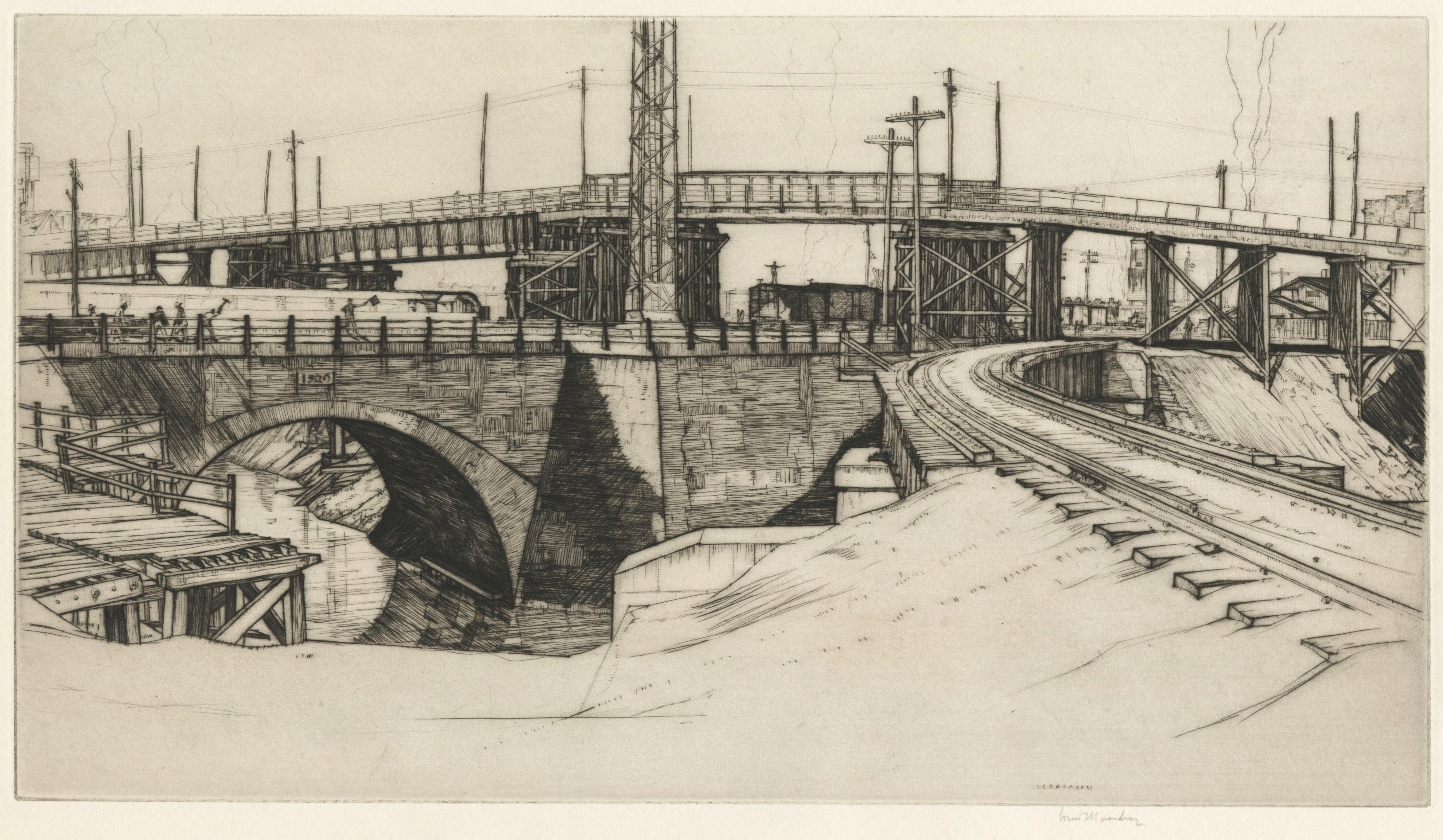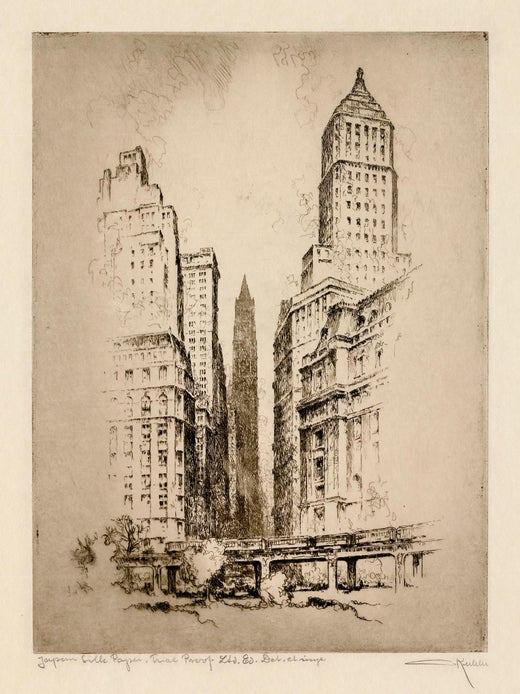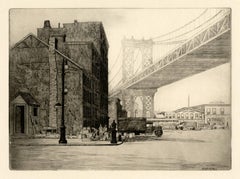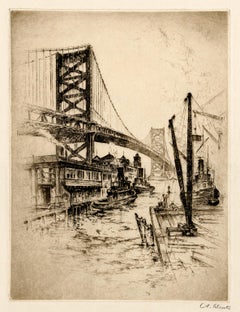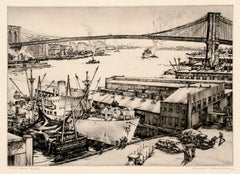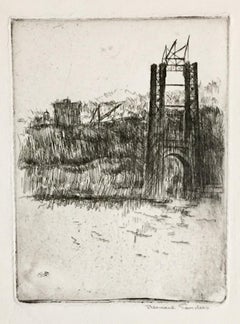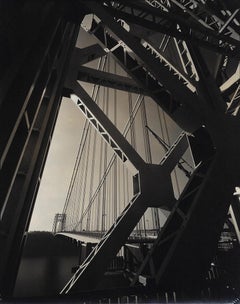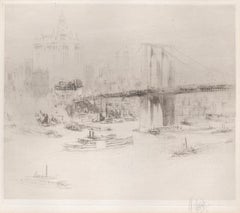Items Similar to 'George Washington Bridge (Under Construction)' — 1920s New York City
Want more images or videos?
Request additional images or videos from the seller
1 of 3
Otto Kuhler'George Washington Bridge (Under Construction)' — 1920s New York City1928
1928
$1,100
£830.14
€950.38
CA$1,551.36
A$1,703.20
CHF 888.57
MX$20,611.15
NOK 11,136.79
SEK 10,493.79
DKK 7,094.37
About the Item
Otto Kuhler, 'George Washington Bridge' (under construction) also titled 'The Cables That Hold it All', etching, 1928, edition unknown. An unsigned proof impression (the rarity of this work suggests that the etching may never have been editioned). A fine, richly-inked impression in warm black ink, with selectively controlled plate tone, on white wove paper; the full sheet with margins (2 to 2 3/4 inches), in excellent condition. Image size 12 13/16 x 9 7/16 inches; sheet size 17 x 14 3/4 inches.
Provenance: Ex. collection Kennedy Galleries, New York.
ABOUT THE IMAGE
The George Washington Bridge is a suspension bridge that spans the Hudson River and connects the Washington Heights neighborhood of Manhattan in New York City with Fort Lee in New Jersey. The idea for the bridge was first proposed in 1906, but it wasn't until 1925 that the state legislatures of New York and New Jersey voted to allow for its planning. Construction on the bridge began in October 1927, and it was ceremonially dedicated on October 24, 1931, before being opened to traffic the next day.
The George Washington Bridge is an important travel corridor for the New York metropolitan area. It has 14 travel lanes, with the upper level having four lanes in each direction and the lower level having three lanes in each direction. The upper deck was expanded from six to eight lanes in 1946, and the six-lane lower deck was constructed beneath the existing span from 1958 to 1962 due to increasing traffic flow. The bridge is considered to be the world's busiest motor vehicle bridge, carrying over 103 million vehicles in 2016.
ABOUT THE ARTIST
Otto Kuhler (1894, Remscheid, Germany -1977, New York City) was a prolific artist and visionary industrial designer whose creative vision left enduring contributions to the worlds of art and transportation.
Kuhler's early years were marked by a deep fascination with machines and technology, a passion that would later shape his artistic career. After studying engineering in Germany, he immigrated to the United States in 1923, where he began to pursue his artistic ambitions in earnest.
Throughout the 1920s and 1930s, Kuhler's distinctive artistic style began to emerge, characterized by bold colors, geometric forms, and dynamic compositions. His modernist aesthetic caught the attention of the burgeoning industrial design community, leading to collaborations with prominent companies such as the American Locomotive Company (ALCO) and the Electro-Motive Corporation (EMC).
Kuhler's most enduring contributions came in the realm of locomotive design, where his innovative concepts revolutionized the aesthetics and functionality of trains. His streamlined locomotives, with their sleek, futuristic designs, captured the spirit of the modern age and helped define the visual identity of rail travel in the mid-20th century. His innovative influence on industrial design and transportation aesthetics is still felt today.
In addition to his work in industrial design, Kuhler was also a prolific painter, illustrator, and printmaker known for his detailed landscapes and dynamic cityscapes. His work often reflected his fascination with technology and machinery, juxtaposing natural and industrial elements to create compelling visual narratives. Kuhler’s printmaking oeuvre was represented by the renowned Kennedy Galleries in New York City.
Kuhler's legacy endures through his extensive body of work, which is represented in galleries, private collections and museums around the world including the Brooklyn Museum, Cleveland Museum of Art, Denver Public Library, Fine Arts Museums of San Francisco, Henry Ford Museum, National Gallery of Art, National Museum of American History, New Mexico Museum of Art, New York Transit Museum, Railroad Museum of Pennsylvania, Roentgen Museum (Remscheid, Germany), University of Missouri at St. Louis, and the Westmoreland Museum of American Art.
- Creator:Otto Kuhler (1894 - 1977, German)
- Creation Year:1928
- Dimensions:Height: 12.82 in (32.57 cm)Width: 9.44 in (23.98 cm)
- Medium:
- Movement & Style:
- Period:
- Condition:
- Gallery Location:Myrtle Beach, SC
- Reference Number:Seller: 1030481stDibs: LU53234926811
Otto Kuhler
Otto Kuhler was one of the best known industrial designers of the American railroads. According to Trains magazine “he streamstyled more locomotives and railroad cars than Cret, Dreyfuss and Loewy combined.” Kuhler’s extensive concepts for the modernization of the American railroads have repercussions on the railways worldwide until today. Also, Kuhler was a prolific artist of industrial aesthetics and the American West in general.
About the Seller
5.0
Recognized Seller
These prestigious sellers are industry leaders and represent the highest echelon for item quality and design.
Platinum Seller
Premium sellers with a 4.7+ rating and 24-hour response times
Established in 1995
1stDibs seller since 2016
321 sales on 1stDibs
Typical response time: 1 hour
Associations
International Fine Print Dealers Association
- ShippingRetrieving quote...Shipping from: Myrtle Beach, SC
- Return Policy
Authenticity Guarantee
In the unlikely event there’s an issue with an item’s authenticity, contact us within 1 year for a full refund. DetailsMoney-Back Guarantee
If your item is not as described, is damaged in transit, or does not arrive, contact us within 7 days for a full refund. Details24-Hour Cancellation
You have a 24-hour grace period in which to reconsider your purchase, with no questions asked.Vetted Professional Sellers
Our world-class sellers must adhere to strict standards for service and quality, maintaining the integrity of our listings.Price-Match Guarantee
If you find that a seller listed the same item for a lower price elsewhere, we’ll match it.Trusted Global Delivery
Our best-in-class carrier network provides specialized shipping options worldwide, including custom delivery.More From This Seller
View AllManhattan Bridge — 1920s New York City
By George Stimmel
Located in Myrtle Beach, SC
'Manhattan Bridge', etching, c. 1920, proofs only. Signed in ink in the image, lower right. A fine, rich impression, in warm black ink, on cream wove ...
Category
1920s American Realist Landscape Prints
Materials
Etching
'Delaware River Bridge' — Mid-Atlantic Regionalism
By Anton Schutz
Located in Myrtle Beach, SC
Anton Schutz, 'Delaware Bridge' (Delaware, New Jersey), etching, c. 1927. Signed in pencil. A superb, richly-inked impression, with skillfully wiped plate tone, on BFK Rives, cream wove paper, the full sheet with margins (1 1/2 to 2 1/8 inches), in excellent condition. Archivally matted to museum standards, unframed.
Image size 11 7/8 x 8 7/8 inches (302 x 225 mm); sheet size 15 7/8 x 12 1/4 inches (403 x 311 mm).
ABOUT THIS IMAGE
The Benjamin Franklin Bridge, originally named the Delaware River...
Category
1920s Realist Figurative Prints
Materials
Etching
'The East River', Brooklyn Bridge — Mid-Century Realism, New York City
By Lawrence Wilbur
Located in Myrtle Beach, SC
Lawrence Nelson Wilbur (1897-1988), 'The East River', drypoint, edition 65, 1946. Signed, titled, and annotated 'A. Jones Proof 1946' in pencil. Signed and dated in the plate, lower ...
Category
1940s American Modern Landscape Prints
Materials
Drypoint
'Brooklyn Bridge' — Iconic New York City Landmark
By Luigi Kasimir
Located in Myrtle Beach, SC
Luigi Kasimir, 'Brooklyn Bridge', color etching with aquatint, 1927, edition 100. Signed in pencil.
A superb impression, with fresh colors, on heavy, cream wove paper; with margins...
Category
1920s American Modern Landscape Prints
Materials
Etching, Aquatint
'Woolworth Building Under Construction' — Early 20th Century Modernism
By Earl Horter
Located in Myrtle Beach, SC
Earl Horter, 'The Woolworth Building Under Construction', etching, c. 1912, edition not stated. Signed in pencil. A fine, richly-inked impression, in warm black ink, with selectively...
Category
1910s American Modern Landscape Prints
Materials
Etching
'The Gateway to the New World' — Vintage New York City
By Otto Kuhler
Located in Myrtle Beach, SC
Otto Kuhler, 'The Gateway to the New World', etching (artist's proof), edition 16, 1926, Kennedy 25. Signed in pencil and annotated 'Japan Silk Paper - Trial Proof - Ltd. Ed. Del. et...
Category
1920s American Modern Figurative Prints
Materials
Etching
You May Also Like
Bernard Sanders, George Washington Bridge Under Construction (from New York)
Located in New York, NY
Clearly a view from New York City across the Hudson River to the New Jersey Palisades, this small format packs a wallop! Construction of the bridge was begun in 1927 and this scene i...
Category
Early 20th Century American Modern Landscape Prints
Materials
Etching
George Washington Bridge, New York, 1931
By Edward Steichen
Located in New York, NY
Signed by the photographer
Category
1930s Photography
Materials
Silver Gelatin
Price Upon Request
George Washington Bridge, New York, 1931
By Edward Steichen
Located in New York, NY
Titled in ink with ‘Photograph by Steichen, 139 East 69th Street, New York City' studio stamp on the reverse of the accompanying paper mount
Category
1930s Photography
Materials
Silver Gelatin
Price Upon Request
Brooklyn Bridge, New York, signed etching by William Walcot, c1925
By William Walcot R. E. Hon. R. I. B. A.
Located in Melbourne, Victoria
Signed in pencil by the artist lower right. William Walcot was born in Russia and moved to London in 1907. He trained and practiced as an architect before devoting himself to archite...
Category
1920s Art Deco Landscape Prints
Materials
Drypoint, Etching
Western Hills Viaduct Under Construction
By Louis Conrad Rosenberg
Located in Fairlawn, OH
Western Hills Viaduct Under Construction
Drypoint, June 1931
Signed in pencil lower right (see photo)
Initialed and dated in the plate lower right above pencil signature (see photo)
From: Cincinnati Series, 1930-1931, 8 plates, this No. 5
Small edition, not specified
From Greenfield Hill
Condition: Excellent
Image/Plate size: 8 1/2 x 15 1/4 inches
Sheet size: 11 1/4 x 18 1/2 inches
Louis Conrad Rosenberg
1890-1983
An American architectural etcher...
Category
1930s American Modern Landscape Prints
Materials
Drypoint
UNDER THE BROOKLYN BRIDGE, EAST RIVER.
By Charles Frederick William Mielatz
Located in Portland, ME
Mielatz, Charles W.(American, born Germany, 1864-1919) UNDER THE BROOKLYN BRIDGE, EAST RIVER. Published by the New York Etching Club, circa 1893. Sign...
Category
1890s Landscape Prints
Materials
Etching
More Ways To Browse
George Washington Antique
Antique Transits
Antique Locomotives
Henry Ford Museum
Antique George Washington Print
Giorgio Morandi On Sale
Gordon Stevenson
Green Jacket Alex Katz
Grun Poster
Guilty Mickey Mouse
Gustavo Rosa
Hajime Namiki
Hall Diteman
Haring Swatch
Harold Cleworth
Heinrich Hirt
Henry Gerbault
Heran Chaban
